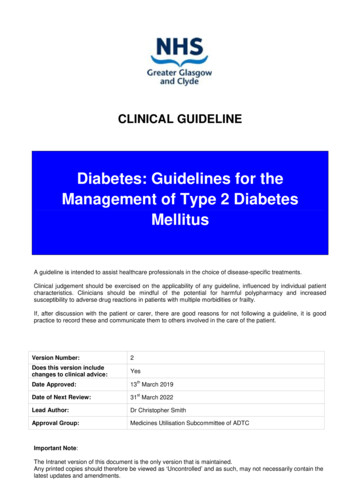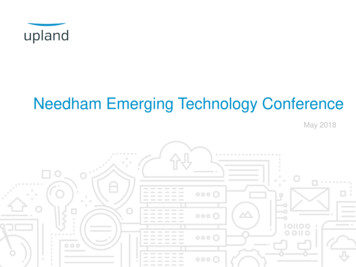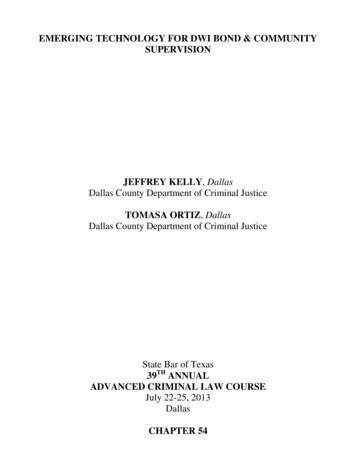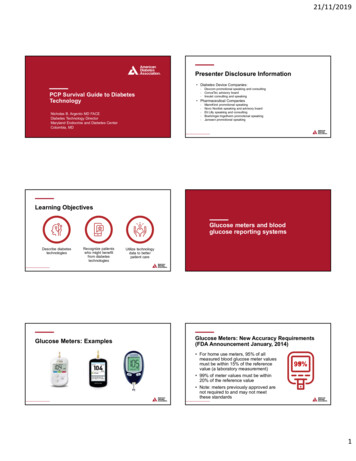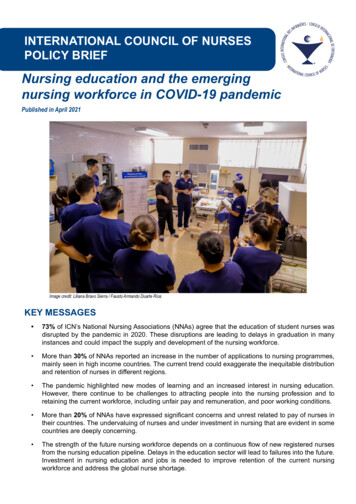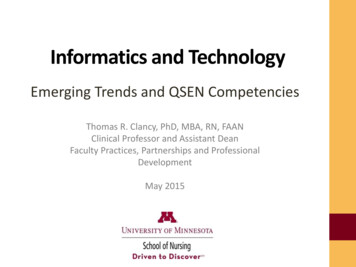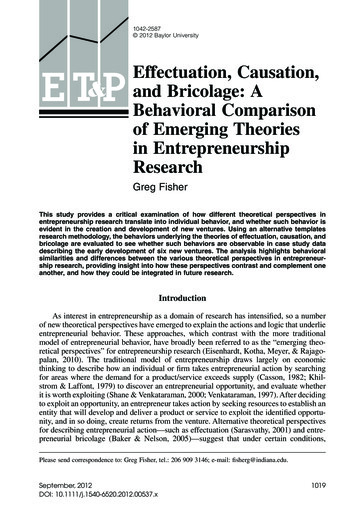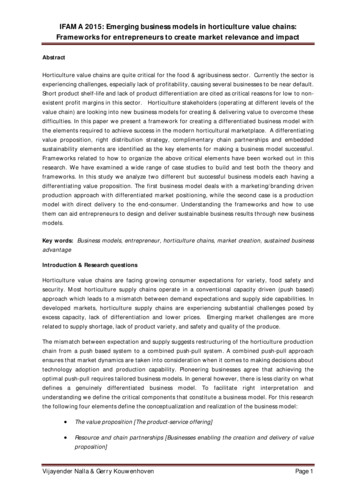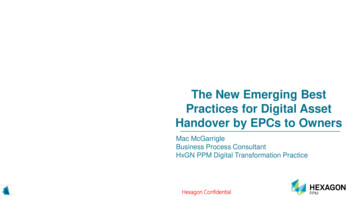
Transcription
Emerging Technologyto Improve Diabetes Carein Federal Medicine
Technology Helps Veterans BetterManage Diabetes During PandemicDURHAM, NC—Across the country, diabetes patientshave faced extraordinary challenges throughout thepandemic.They disproportionately suffer from acute COVID-19and experience higher rates of hospitalization and death.Shelter-at-home orders, job losses and distribution issuesmade finding adequate, nutritious and healthy food difficult for many. Closures of hospitals and clinics, deferralof nonessential care and social isolation reduced supportfrom healthcare professionals and trained caregivers andled to poor disease management. Many healthcare systems struggled to create new options from scratch, leaving patients in the lurch for months.But not the VA.Veterans continued to receive care, kept regularappointments with their clinical team, provided updatedglucose readings, monitored diabetic foot ulcers and eyecomplications, received automated medication refills,had access to yoga and cooking programs, and in somecases received necessary food deliveries thanks to theVA’s long-standing commitment to the use of technology. The department couldn’t make COVID-19 lessvirulent, but it could—and did—reduce the impact thecoronavirus had on the lives of veterans with diabetes.B enefitsfor remote patient monitoring, from smartphones topulse oximeters to foot pads.2The switch to telehealth put veterans in a better position than many of their neighbors. In a survey by theAmerican Diabetes Association (ADA), 43% of diabetics reported delaying medical care during the pandemic, often because they feared contracting COVID19. Veterans with diabetes had an option to stay homeand receive care, allowing the vast majority to keep theirappointments with their primary care teams, nutritionistsand endocrinologists.Some veterans who needed more structured careimproved as a result of telehealth. “While telehealthhas proven efficacious for diabetes in research settings, intensive telehealth interventions have rarelybeen implemented in standard care,” said ElizabethKobe, MD candidate at Duke University MedicalSchool. Kobe presented the results of an intensive telehealth intervention at the ADA’s 80th Virtual ScientificSessions in June 2020.Using existing VA home telehealth infrastructure andstaff, Kobe and her colleagues designed and implementeda six-month telehealth intervention that combined telemonitoring with a module-based self-management support and medication management program. Clinical staffcalled patients every two weeks for 30 minutes. Patientstransmitted their blood glucose measurements daily viahome telehealth-issued equipment.Her study found that participants in the AdvancedComprehensive Diabetes Care (ADCD) programimproved their HbA1c by a mean of 1.36 points oversix months, dropping to 7.89% and persisting for at least18 months. While the study began before the pandemic,veterans continued to participate and benefit throughoutof T elehealthThe VA has been a national leader in telehealth for morethan 20 years, in large part because 25% of veterans livein rural areas. The need to provide care to those wholived a significant distance from VA facilities promptedthe department to develop ways to bring care closer.Increasingly, that’s meant into the veteran’s home.As a consequence, when the pandemic closed manyhospitals and clinics to non-COVID-19 care, the VA waswell positioned to quickly offer care throughalternative means—its robust telehealth services. It took the VA Connecticut Health CareSystem, for example, just three weeks to tranThe Initiative to End Diabetic Limbsition from seeing nearly all patients in personLoss at VA (TIEDLLV), supplies at-risk,to conducting 97% of all primary care visitsdiabetic veterans with Podimetricsvirtually, and at close to the same volume. 1Endocrinologists and other specialists rapMats, which can detect foot ulcersidly adopted e-consults and e-referrals andup to six weeks before they wouldvideo-to-home visits, particularly for highrisk patients. To maximize the value of thosebe identified in an exam and from thevisits, the VA reallocated funds to expand itscomfort of their home.national loaned tablet program to patientswith access issues and delivered other devices2Emerging Technology to Improve Diabetes Care in Federal Medicine
2020. “Despite the drastic changesthat COVID-19 has forced us tomake, ACDC delivery has continuedunabated,” Kobe said.Beyond being able to contact healthcare providers, telehealth enables veterans to learn how to better managetheir diabetes and participate in groupsessions. In January 2021, the ADAawarded recognition status to the VAand DoD’s Diabetic Self-ManagementEducation (DSME), calling it one ofthe most engaging and true-to-lifevirtual medical experiences focusedentirely on diabetes self-management.Veterans access DSME through theVA’s Virtual Medical Center (VMC).Using customizable avatars, veteransnavigate the VMC, which looks muchArmy Veteran William Baker, who has Type 2 diabetes, discusses his healthlike most VA hospitals. Through thewith LaCresha Mitchum, a registered nurse and certified diabetes educator anddiabetic coordination at the William Jennings Bryan Dorn VAMC in Columbia, SC.avatars, veterans attend any class in the—Photo by Jennifer Scales, Dorn VAMCvirtual facility, ask diabetes educatorsquestions and discuss issues with othlose their lives because of complications from diabeticers in their classes.foot ulcers,” said Suzanne Shirley, VHA Innovation“At first, the Virtual Medical Center was intimidating,Ecosystem director of partnerships and communitybut they have a lot of support staff,” said Orville Bell, aengagement. “I knew we had to tackle this problem and70-year-old Navy veteran. “I really like it because theyfind a solution. Once we saw the results from the use ofkeep me focused on how to eat, make good diet deciremote temperature monitoring, we worked to make suresions. I also like listening to how other people remainthat it became a part of VA’s diabetic care.”disciplined. It’s kind of like being in ‘Diabetes Watchers’The Tomah VAMC uses teleretinal imaging to detectinstead of Weight Watchers.” With encouragement fromchanges in the eye for veteran with diabetes. A specialthe program, Bell has lost 30 pounds and dropped hiscamera captures images of the lining of the eye whichHbA1c from 11 to 6.7.medical staff sent to optometrists to evaluate. The reducC onnected D evicestion in the number of appointments and travel requiredfor diagnosis and treatment has been particularly valuDiabetes can lead to foot ulcers, which account for 80%able with COVID-19 in circulation.of nontraumatic amputations in veterans, and to dia“Providing safe care to our veterans in locations conbetic retinopathy, the most common cause of blindnessvenient to them leads to regular use of technology andin American adults. The VA was determined to providetelehealth services,” said Karen Long, Tomah VAMC’scare to limit both of these frequent complications despiteacting director. “We are proudly leveraging our virtualthe pandemic. To do so, they enlisted the help of technolcare tools to ensure our patients and staff are as safe asogy again.possible.”The Initiative to End Diabetic Limb Loss at VA1(TIEDLLV), supplies at-risk, diabetic veterans withSpelman JF, Brienza R, Walsh RF, Drost P, Schwartz AR, KravetzPodimetrics Mats, which can detect foot ulcers up to sixJD, Pitkin P, Ruser C. A Model for Rapid Transition to Virtual Care,VA Connecticut Primary Care Response to COVID-19. J Gen Internweeks before they would be identified in an exam, and fromMed. 2020 Oct;35(10):3073-3076. doi: 10.1007/s11606-020-06041the comfort of their home. A veteran stands on the mat once4. Epub 2020 Jul 23. PMID: 32705471; PMCID: PMC7377306.a day, and in 20 seconds the device measures the temper2Heyworth L, Kirsh S, Zulman DM, Ferguson JM, Kizer KW.ature of the feet using thermal imaging and transmits theExpanding Access through Virtual Care: The VA’s Early Experienceinformation Podimetrics’ cloud-based artificial intelligencewith COVID-19. NEJM Catalyst: innovations in care delivery. 2020system. The AI analyzes the data and alerts the provider ifJul 1; 0327.there are signs of a developing diabetic foot ulcer.3Kobe EA, et al. Implementation of an intensive telehealth intervenEarly results indicate that the Podimetrics system almosttion for rural patients with uncontrolled diabetes. Presented at:entirely eliminates severe ulcers and reduces ulcer-assoAmerican Diabetes Association Scientific Sessions; June 12-16,ciated hospitalizations by 92%. “I saw countless Veterans2020 (virtual meeting).Emerging Technology to Improve Diabetes Care in Federal Medicine3
Pandemic Highlights Benefits ofContinuous Glucose MonitorsNot Just for Type 1 Diabetes, CGM Now Aids Some Type 2 PatientsBALTIMORE, MD—For veterans with diabetes, managing their numbers has never been more important.While diabetes does not increase the risk of contractingCOVID-19, it sharply increases the risk of severe disease and death.Multiple studies have shown that Type 1 or Type 2 diabetes at least doubles and possibly quadruples the risk ofdeath in individuals infected by SARS-CoV-2, the virusthat causes COVID-19. Half of deaths in individualsyounger than 65 have occurred in people with diabetes,according to the U.S. Centers for Disease Control andPrevention. Diabetics with poorly controlled serum glucose levels have the highest risk of more severe disease.Those numbers translate into substantially greater riskfor the 25% of veterans with diabetes. They also illuminate a way to improve outcomes for coronavirus infections and other infections in these veterans. It has longbeen known that people with diabetes have a harder timebattling viral, bacterial, or fungal infections becausethey do not process glucose as well, they have a weakerimmune response, and often have circulatory issues.Because elevated blood sugar directly impairs immunesystem response, closely managing glucose levels hastaken on greater importance during the pandemic forhospitalized patients with COVID-19 and people withdiabetes who want to minimize their risk. As a result,the use of continuous glucose monitors (CGM) has risenmarkedly over the last year across all settings.CGM U seinH ospitalsHospitals quickly saw the advantages of CGM duringthe novel coronavirus outbreak. The need to reduce therisk faced by overtaxed nursing staff and preserve personal protective equipment made the pre-pandemic standard of testing for blood glucose levels untenable.“Typically, glucose monitoring relies on point-of-carefinger sticks which must happen frequently to preventadverse events in patients with diabetes,” said Thomas J.Hornyak, MD, PhD, associate chief of staff for Researchand Development at the VA Maryland Health CareSystem (VAMHCS). For patients in intensive care whorequire insulin, standard procedures called for capillarytesting of blood glucose levels every one to two hours,a requirement that became impossible to meet as hospitals converted other units, floors, and offices to intensivecare units to treat COVID-19 patients, many of them diabetic. Other hospitalized patients also required frequentblood glucose testing.4Reducing or eliminating glucose monitoring wasn’t aviable option. “Studies have indicated that insulin usein hospitalized patients with diabetes predisposes themto hypoglycemia, a condition that is associated withincreased morbidity and mortality. Preventing hypoglycemia requires intensive glucose monitoring,” explainedIlias Spanakis, a physician and researcher at VAMHCSand associate professor at the University of MarylandSchool of Medicine. Hyperglycemia has also emerged asan indicator of poor prognosis in COVID-19.In light of the urgent need, the U.S. Food and DrugAdministration issued guidance in April 2020 allowingthe use of CGMs to monitor blood sugar levels in hospitalized patients during the pandemic. The AmericanDiabetes Association (ADA), Insulin for Life and theDiabetes Disaster Response Coalition quickly partneredwith Abbott to donate 25,000 CGM sensors to hospitalsacross the country.Like many hospitals around the country, VAMHCSturned to continuous glucose monitoring systems,which check glucose levels every five minutes and sendthe results to a centralized monitoring device at thenurses station. Spanakis and his colleagues comparedCGM results to standard care in a study published inDiabetes Care.“Dr. Spanakis’ study demonstrates that glucose levels can be monitored more frequently and efficiently,”Hornyak added. “Also, in the face of the COVID-19pandemic, use of the continuous glucose monitoringsystems proved to be prescient, showing a decrease inhypoglycemia while also safeguarding health care providers caring for virus-positive patients with diabetes.”1Several small trials indicated CGMs offer similar benefits in ICUs and other wards. 2An international panel of experts in diabetes technology, including VA researchers, issued a strong recommendation for the use of CGMs to reduce nurse contactand use of PPE for frequent glucose testing in hospitalized patients isolated with “highly contagious infectiousdiseases (e.g., COVID)” in September 2020.3That recommendation followed implementation recommendations by a U.S. panel that included Spanakisand Francisco Pasquel, MD, MPH, of the Atlanta VAMC.They concluded that “CGM may be on the threshold ofbecoming a widely accepted form of continuous automated physiologic monitoring in the hospital setting.”The pandemic provided opportunities for greater usean analysis of CGMs outside the hospital, too. RestrictedEmerging Technology to Improve Diabetes Care in Federal Medicine
access to clinics and in-person appointallow patients to proactively treat theirments drove the adoption of telehealthdiabetes and prevent the need for hoson a broad scale, a trend likely to conpital-based diabetic care. Practitionerstinue after the pandemic recedes.will also have greater flexibility to“Based on the experience that weallow more of their diabetic patientshave obtained with the current crito better monitor their glucose andsis, I predict that several things mayadjust insulin doses from home bychange in the near future, affectingusing a therapeutic continuous gludrastically how we manage patientscose monitor” during the pandemic.with diabetes,” Spanakis observedFurther expansion is likely to occurin an editorial. “With so many telein the future. Michael Bergman, MD,medicine platforms available evensection chief of endocrinology at thenow, the vast majority of the outVA NY Harbor Healthcare System andpatient visits will be transformed todirector of NYU Langone’s Diabetestelehealth appointments.”4Prevention Program is studying theBecause diabetes management reliesuse of the Abbott FreeStyle LibreSource: Diabetes Care 2020;43:2736–2743 https://doi.org/10.2337/dc20-0840CGM as a screening tool for highon tracking numbers, the data-sharingrisk individuals in the outpatient setcapability of continuous glucoseting. The study team also is testing the device to identifymonitors and insulin pumps facilitates better managementblood glucose abnormalities in veterans admitted to theduring virtual visits. “The abundance of data provided byManhattan campus of the VA NYHHS with acute coroCGM offers opportunities to analyze patient data morenary syndrome. Picking up glucose abnormalities early,granularly than was previously possible, providing addibefore a patient reaches prediabetic levels or has diabetes,tional information to aid in achieving glycemic targets,”can head off development of the disease altogether.according to the ADA’s Standards of Medical Care in“So far, the data look very compelling, and if the resultsDiabetes-2021. The ADA recommends that CGM devicesremain consistent, the use of the CGM would be a muchshould be considered for all patients prescribed insulin.5simpler and practical approach to screening for glucoseThe data from CGMs help patients take more control ofdisorders than asking patients to undergo the [oral glutheir diabetes between visits, too. “You can look at trendcose tolerance test] in a clinical laboratory,” Bergmananalysis and a whole bunch of different things that arederived from that technology. The data allows you to makesaid. “I think it would promote more reliable screeningsome pretty good decisions and see what’s going on withthan what is done currently.”1your body,” Army veteran Jason Syr told 12WBOY. Syr’sSingh LG, Satyarengga M, Marcano I, Scott WH, et. al. Reducing Inpatient Hypoglycemia in the General Wards Using Real-timededicated use of a CGM allowed him to stay in the ArmyContinuous Glucose Monitoring: The Glucose Telemetry System, afor six more years after his diagnosis of Type 1 diabetes.Randomized Clinical Trial. Diabetes Care. 2020 Nov;43(11):2736The DoD and VA have covered CGMs for Type 1 dia2743. doi: 10.2337/dc20-0840. Epub 2020 Aug 5. PMID: 32759361;betes for years. Just in time for the pandemic, the DoDPMCID: PMC7576426.expanded authorization to include CGM for service2Galindo RJ, Aleppo G, Klonoff DC, Spanakis EK, et. al. Implemenmembers with uncontrolled Type 2 diabetes, as well.tation of Continuous Glucose Monitoring in the Hospital: Emergent Considerations for Remote Glucose Monitoring During theIn 2019, VA began authorizing CGMs for veterans whoCOVID-19 Pandemic. J Diabetes Sci Technol. 2020 Jul;14(4):822use insulin and require frequent blood glucose testing to832. doi: 10.1177/1932296820932903. Epub 2020 Jun 14. PMID:manage their Type 2 diabetes.32536205; PMCID: PMC7673156.CGMs have been shown to help manage diabetes in3Galindo RJ, Umpierrez GE, Rushakoff RJ, Continuous Glucosethis group. A previous study conducted at the MalcomMonitors and Automated Insulin Dosing Systems in the HospitalRandall VAMC in Gainesville, FL, found that veteransConsensus Guideline. J Diabetes Sci Technol. 2020 Nov;14(6):1035with diabetes who either required insulin or had A1c1064. doi: 10.1177/1932296820954163. Epub 2020 Sep 28. PMID:32985262; PMCID: PMC7645140.levels above 7% who received a CGM had significantly4Spanakis E. Diabetes and Technology in the Covid-19 Panimproved glycemic control and expressed 100% satisdemic Crisis. J Diabetes Sci Technol. 2020 May; doi.faction with the device.6org/10.1177/1932296820929385.Last November, VA relaxed its restrictions on who could5American Diabetes Association. 7. Diabetes Technology: Standardsuse the devices to “permit COVID-19 patients to moreof Medical Care in Diabetes-2021. Diabetes Care. 2021 Jan;44(Supplclosely monitor their glucose levels given that they are at risk1):S85-S99. doi: 10.2337/dc21-S007. PMID: 33298418.for unpredictable impacts of the infection on their glucose6Barsamyan G, Da Silva A, Whyte L, Amole M, Ghayee H, Leey JA.levels and health,” said Kameron Leigh Matthews, MD.855-P: Utilization of Continuous Glucose Monitoring (CGM) andFurther, Matthews noted in a memo to VISN directors,Its Impact on the Care of Veterans. Diabetes. Jun 2020, 69 (S1) 855P; DOI: 10.2337/db20-855-P.“the use of therapeutic continuous glucose monitors mayEmerging Technology to Improve Diabetes Care in Federal Medicine5
Apps, Wearable Devices Increasingly HelpVeterans Improve Diabetes ManagementTAMPA, FL—Like Americans everywhere, veteransthe accompanying Fitbit app to record their food andhave integrated smartphones and wearable devices intoactivity. Only two veterans left the study before its conmany aspects of their lives. For veterans with diabetes,clusion at six months.1those devices, healthcare and wellness apps are increas“[A}lthough one might expect reduced interest in theingly transforming care and improving outcomes.program due to disruptive stressors related to the pan“VA’s Office of Connected Care has made significantdemic, participant responses reflected a high degree ofst
that it became a part of VA’s diabetic care.” The Tomah VAMC uses teleretinal imaging to detect changes in the eye for veteran with diabetes. A special camera captures images of the lining of the eye wh
